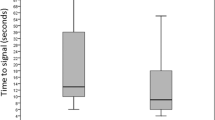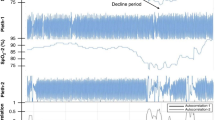Abstract
A case of a neonate with Rhesus hemolytic disease of the newborn who went on to develop bronze baby syndrome (BBS) is reported. During his admission, inconsistencies between pulse oximetry saturations (SpO2) and his arterial partial pressure of oxygen (PaO2) measurements raised the suspicion of interference with our SpO2 monitoring. Although bilirubin has been heavily investigated with respect to SpO2 interference, a brown pigment has been shown to be produced in patients with BBS, which exhibits spectral absorbances that may cause interference with the pulse oximeter. This needs further exploration, but highlights the need to interpret SpO2 readings with caution in neonates with BBS.
This is a preview of subscription content, access via your institution
Access options
Subscribe to this journal
Receive 12 print issues and online access
$259.00 per year
only $21.58 per issue
Buy this article
- Purchase on Springer Link
- Instant access to full article PDF
Prices may be subject to local taxes which are calculated during checkout
Similar content being viewed by others
References
Hay Jr WW, Rodden DJ, Collins SM, Melara DL, Hale KA, Fashaw LM . Reliability of conventional and new pulse oximetry in neonatal patients. J Perinatol 2002; 22: 360–366.
Moyles JTB . Uses and abuse of pulse oximetry. Arch Dis Child 1996; 74: 77–80.
Schnapp LM, Cohen NH . Puse oximetry: uses and abuses. Chest 1990; 98: 1244–1250.
Ralston AC, Webb RK, Runciman WB . Potential errors in pulse oximetry III: effects of interference, dyes, dyshaemoglobins and other pigments. Anaesthesia 1991; 46: 291–295.
Bertini G, Dani C, Fonda C, Zorzi C, Rubaltelli FF . Bronze baby syndrome and the risk of kernicterus. Acta Paediatr 2005; 94: 968–979.
Rubaltelli FF, Da Riol R, D'Amore ES, Jori G . The bronze baby syndrome: evidence of increased tissue concentration of copper prophyrins. Acta Paediatr 1996; 85: 381–384.
Kopelman AE, Brown RS, Odell GB . The ‘bronze’ baby syndrome: a complication of phototherapy. J Pediatr 1972; 81: 466–472.
Rubaltelli FF, Jori G, Reddi E . Bronze baby syndrome: a new porphyrin-related disorder. Pediatr Res 1983; 17: 327–330.
Acknowledgements
I would like to thank Dr William W Hay Jr for his advice and support in composing this paper.
Author information
Authors and Affiliations
Corresponding author
Rights and permissions
About this article
Cite this article
Hussain, S. Pulse oximetry interference in bronze baby syndrome. J Perinatol 29, 828–829 (2009). https://doi.org/10.1038/jp.2009.35
Received:
Revised:
Accepted:
Published:
Issue Date:
DOI: https://doi.org/10.1038/jp.2009.35



